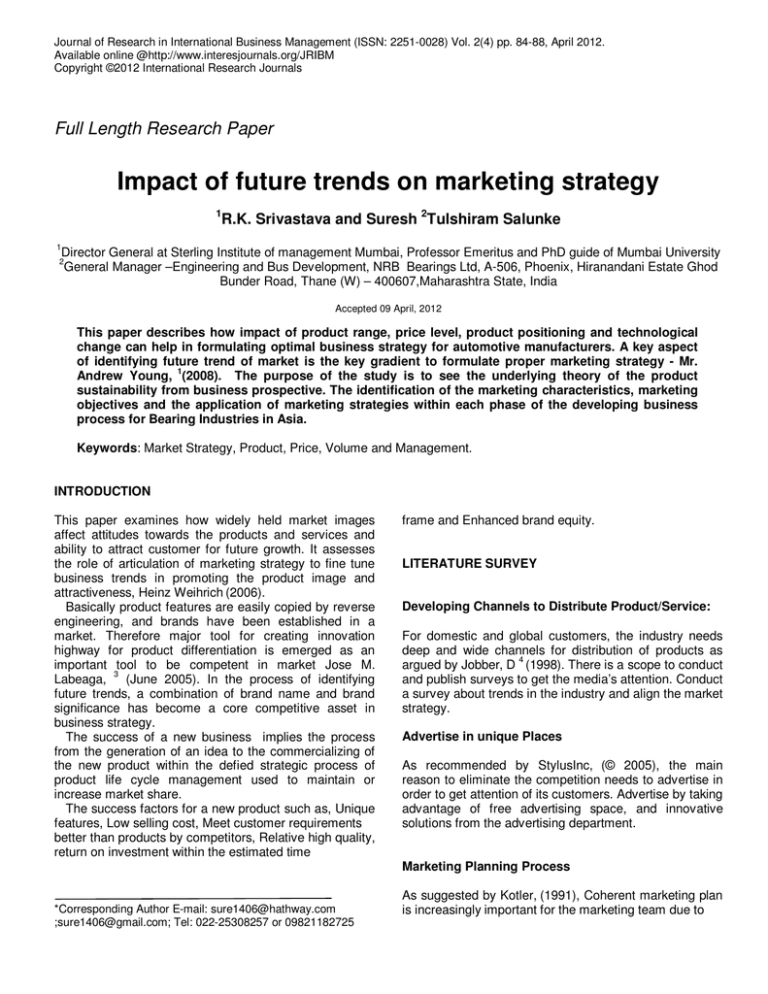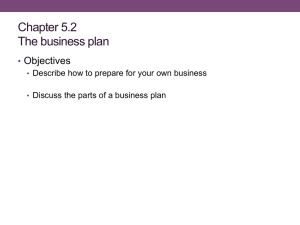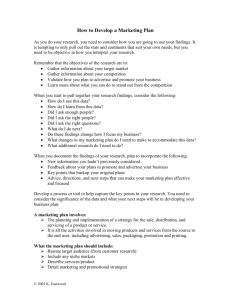Document 14249028
advertisement

Journal of Research in International Business Management (ISSN: 2251-0028) Vol. 2(4) pp. 84-88, April 2012. Available online @http://www.interesjournals.org/JRIBM Copyright ©2012 International Research Journals Full Length Research Paper Impact of future trends on marketing strategy 1 R.K. Srivastava and Suresh 2Tulshiram Salunke 1 Director General at Sterling Institute of management Mumbai, Professor Emeritus and PhD guide of Mumbai University General Manager –Engineering and Bus Development, NRB Bearings Ltd, A-506, Phoenix, Hiranandani Estate Ghod Bunder Road, Thane (W) – 400607,Maharashtra State, India 2 Accepted 09 April, 2012 This paper describes how impact of product range, price level, product positioning and technological change can help in formulating optimal business strategy for automotive manufacturers. A key aspect of identifying future trend of market is the key gradient to formulate proper marketing strategy - Mr. Andrew Young, 1(2008). The purpose of the study is to see the underlying theory of the product sustainability from business prospective. The identification of the marketing characteristics, marketing objectives and the application of marketing strategies within each phase of the developing business process for Bearing Industries in Asia. Keywords: Market Strategy, Product, Price, Volume and Management. INTRODUCTION This paper examines how widely held market images affect attitudes towards the products and services and ability to attract customer for future growth. It assesses the role of articulation of marketing strategy to fine tune business trends in promoting the product image and attractiveness, Heinz Weihrich (2006). Basically product features are easily copied by reverse engineering, and brands have been established in a market. Therefore major tool for creating innovation highway for product differentiation is emerged as an important tool to be competent in market Jose M. 3 Labeaga, (June 2005). In the process of identifying future trends, a combination of brand name and brand significance has become a core competitive asset in business strategy. The success of a new business implies the process from the generation of an idea to the commercializing of the new product within the defied strategic process of product life cycle management used to maintain or increase market share. The success factors for a new product such as, Unique features, Low selling cost, Meet customer requirements better than products by competitors, Relative high quality, return on investment within the estimated time frame and Enhanced brand equity. LITERATURE SURVEY Developing Channels to Distribute Product/Service: For domestic and global customers, the industry needs deep and wide channels for distribution of products as 4 argued by Jobber, D (1998). There is a scope to conduct and publish surveys to get the media’s attention. Conduct a survey about trends in the industry and align the market strategy. Advertise in unique Places As recommended by StylusInc, (© 2005), the main reason to eliminate the competition needs to advertise in order to get attention of its customers. Advertise by taking advantage of free advertising space, and innovative solutions from the advertising department. Marketing Planning Process *Corresponding Author E-mail: sure1406@hathway.com ;sure1406@gmail.com; Tel: 022-25308257 or 09821182725 As suggested by Kotler, (1991), Coherent marketing plan is increasingly important for the marketing team due to Srivastava and Salunke 85 expanding market opportunities, the growing risk of allocating substantial resources into new innovations, with high R and D costs and the increasing complexity of a firm's international marketing operations. Successful strategic marketing plan within an organization can: a) Determine where to place efforts, b) Identify which markets to segment or target, c) Provide a measure for assessment, d) Create business case with advantage(s). As the product life saturates, a variety of products will be narrowed down as per the manufacturing system designed for Continuous flow. The purpose of “Trend of Production System” is used in the discussion for the initial stage of new product development [NPD] and for ramp up and formulation of production plan for two, three, four and five years. Impact of total range of product Time Perspective As argued by Jobber. D 1 (1998) demands address long term planning which verify and track broad market trends, sets major organizational strategies, and deploys resources to fulfill these strategies for two, three and five years. Therefore, organizations work towards more focused short-term targets, which set out clear tactical approaches in the marketing mix and draw up viable action plans to fulfill clear short-term objectives. In the current competitive environment in which firms operate, greater flexibility is necessary in the planning process to permit adequate and timely adjustment of both short term and long term planning. • Customer Perspective: As per Gerald B. White and Wen-fei L. Uva (2000) requirement of a global application in engineering to support and clearly capture the customer perspective and pin point the seed of innovation. The main aim is to identify new and emerging customer needs. • Requirement of survey on estimated size & potential of valid customers Mackie, (2004). Identification of economic drivers at customer markets and to find out strengths and weaknesses of competitors. • Advertise in unique Places: As recommended by StylusInc, (© 2005), the main reason to advertise where nobody else involved in the bearing industry advertises by taking advantage of free advertising space, and innovative solutions from the advertising department. Price Level As argued by Robert G. Cooper 7 (2001p.357-389), identifies process for future trend of pricing arenas for new market strategy in three dimensions. Customer function served - It consists of a large list but few are application support, services, convenient in usage and many more. Technology utilized - Innovation and investment are required to develop and supply consistent quality products. Process of amortizing development cost, specific customer requirement and impact of economical lot size and life cycle of product. Above guideline covers pricing for total product group as recommended by Robert G. Cooper [2001]. Trend of Production System for ideal marketing strategy As suggested by John Miltenburg, (2005, p.303-305), the production systems are based on the products life cycle. The Figure 2 below elucidates different types of production systems from the concept creation stage to the end of product life cycle. Product and volumes are linked with the sales forecast. The risk involved at the developmental stage is low because the investments are carefully spent on the production system for small and large batches considering the product life cycle. PROPOSED HYPOTHESIS Exploratory Research Research is exploratory because no earlier model with a basis of study on the success of new products in an industrial market is available. The first reasons to invent paper, not restricting the description to the topics that have been documented in earlier studies. The reason is to find processes and strategies for new product success, which existing theories are the main criteria to discuss. In a new approach marketing planning process will be at the Business and product level and these steps are outlined in the process below: Business Level Establishing the Business Mission, Undertaking a Marketing Audit, Formulating a SWOT Analysis, Generation and evaluation of strategic alternatives, Setting Marketing objectives Product Level Developing core strategy, Outlining marketing mix decisions, Organizing and implementing plans, monitoring and control of plans. 86 J. Res. Int. Bus. Manag. How: Technologies require to design, develop, product ionization cost, cost of infrastructure, suppliers development cost, internal development costs, cost of atomization, product life...etc What: Applications where customer need to be satisfied. Who: Customer Groups to be served (market or segment market like OEM, Industrial or after market ... etc. Home base for product pricing FIG-1 NEW PRODUCT PRICING ARENAS [Source: Robert G. Cooper 7 [2001], Winning At New Products, (p.377), New York, ISBN-13 978-0-7382-0463-5] PRODUCTS and VOLUME LAYOUT and MATERIAL FLOW Very many productone or few each Functional layout; flow extremely varied Cellular layout; flow varied with pattern Line flow-Operatorpaced; flow mostly regular Many products - low volume Much products medium volume Several product -high volume s One product - very high volume Job Shop Batch Flow Operator-Paced Equipment-Paced Line FMS Line flow-equipmentpaced; flow regular Continuous-Flow Continuous flow; flow rigid Product Life Cycle and the Production System. [Source: John Miltenburg, 8 (2005, p.303) Figure 2. Product life cycles (PLC) and the production system. Srivastava and Salunke 87 DISCUSSION and RESULTS Impact of future trend on marketing Strategy “I find the great thing in this world is not so much where we stand , as in which direction we are moving: To reach the port of heaven, we must sail sometimes with the wind and sometimes against it but we must sail, and not drift, and not lie anchor”….Oliver Wendell Holmes, The Autocrat of the Breakfast Table,1858. Phenomenological studies make detailed comments about individual situations, which do not lend themselves to direct generalization or conclusion. The development of general theories from phenomenological findings needs transparency, if it is to have the validity to verify how research has arrived at individual interpretations. As Robert Y Kin(2009,pp 127-162),case study guide line. • First by using general strategy based on theoretical proposition, reduced potential analytical difficulties • Second, to achieve high quality case studies research five techniques used- Pattern matching, explanation building, time series analysis, logic models, and cross case synthesis. Winning factors for the success of the product Considering the importance of a new product for the business performance of an organization, it is vital to identify critical success factors and measures. Criteria for customer satisfaction It is a well-known fact that no business can exist without customers. Select tips that will make your clients feel valued, wanted and loved. Impact of total range of product: Possible to capture market globally in all continents where automotive manufacturers exist as per technology management technique Angela Clarke 11, April (2006). Industrial equipments are available and an alternative to competitor will be present in the aftermarket requirement. Technological Change This topic addresses the aspect of technological change from the generation of idea based on the personal discussion with Dr. Robert G. Kooper6 on 15th September 2008 at Mumbai that can be a potential trend that can affect marketing strategy. The process can set from a holistic and a complete lifecycle perspective to product conception and development and this too is right from the first stage of customer awareness to the final disposal. The aim is to plan for a product for at least three generations ahead and the time will vary depending upon the organization and the product. Differentiating and Creating Visibility For specific product it needs to stand out from its competitors based on price or value or developing a niche in the market to become a dominant player. That is possible to become more visible to each of the customer groups and its competitors serve by developing a marketing communications strategy and branding strategies will help do this. Learning from competitors Observe the marketing methods that are successful for your competitors, improve on them to suit business, and incorporate these methods into your own marketing program. The broad characteristics of innovative products from competition prospect are as under. Possibility of eliminating steps at application point- Way to simplify customer needs to accomplish. Next step required at the customer level is to validate the performance of the product. The Entire ecosystem within which the product is used and furthers the exploration of opportunities for service innovation. Identify whether too much of creativity is killing the system of innovation. Rational benefits of innovative productCheaper, higher life than standard product, faster acting, cleaner, easy in handling and using, protecting other parts, sting free, manageable, less noise, trying toward zero warranty etc. Emotional benefits of innovative productAttractive, cheaper, self assured, soothing, flattering, sophisticated, environmental. CONCLUSION • International marketing will increase the portfolio for expansion of business. • Future trends on marketing strategy influenced by the total range of the product, pricing level, production facility, technological change and competitor behavior. Finally, strategy will be customized based on the customer situation of that particular business scenario. 88 J. Res. Int. Bus. Manag. • Need of a good marketing strategy for the success of a product is based on uninterrupted review & augmentation of business and marketing strategies. Moreover, the identification of best customers, capability to overcome on strong competitors, potential of elimination of commoditization, importance of product range are important parameters to drive towards a vision of organization . FURTHER WORKS The impact of incremental, substantial and break through, innovations ought to be interesting since these can create greater impact on firms and industries. The present system in this research can hopefully support the future research results that can transfer to practicable implementation in all three areas of innovation ACKNOWLEDGEMENT Special thanks to my faculty member - Professor Dr. R.K Srivastava from SIMSR and Mr. Andrew Young Warwick UK for their endearing support & insightful guidance while mentoring me for this module. Special thanks to auto component manufacturer who provided me with substantial and valuable information without which this paper would not be possible to accomplish. I am overwhelmed to have had a chance to work with selfless, humble and intellectual individuals from whom I have learnt so much and who have encouraged me to go beyond my aims. I would like to thank all those who do not find a mention here, without whom this work would not have been completed. REFERENCES Andrew Y (2008), Strategic Marketing, WMG Module, Presented, 25-29 November 30, 2008 at Mumbai India. Heinz W( 2006) Professor of Management, University of San Francisco Volkswagen. P. 7 Jose ML (2005). Persistence and ability in the innovation decision, Documento De Trabajo June 2005. P. 16. Jobber D (1998) Principles and Practice of Marketing, London: McGrawHill. P. 14 StylusInc Pvt. Ltd. All rights reserved, Copyright © 2005. http://www.stylusinc.com/Common/AboutUs/Services.php; Kotler P (1991) Marketing Management: analysis, planning, implementation and control, 7th Edn. Englewood Cliffs, NJ: Prentice Hall. P. 6 Robert GC ( 2001). Winning at New Products, 3rd edn, New York: Perseus Book group. Pp. 17-28 John M (2005). Manufacturing Strategy, 2nd .ed. New York: Productivity Press. P. 6 Gerald BW, Wen-fei LU (2000). [EB 2000-01 Developing a Strategic Marketing Plan for Horticultural] P. 3 Mackie ( 2004). Strategic Marketing, MKT 382.4 – Unique 04440, fall, (2004). P. 7 Angela C (2006). Technology Management, WMG Module. Presented, 10-14 April 2006 at Mumbai India. P. 12 th Robert YK(2009). Case Study Research , 4 ed. California USA:SAGE publication. Pp. 127-162


